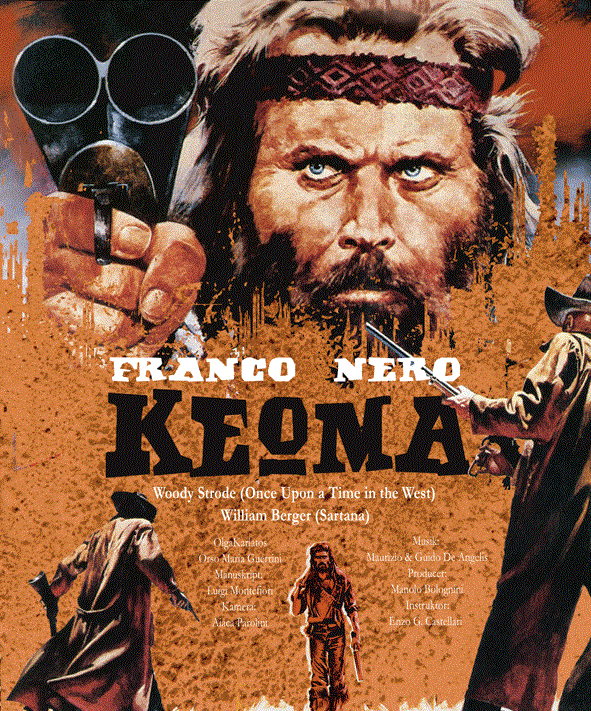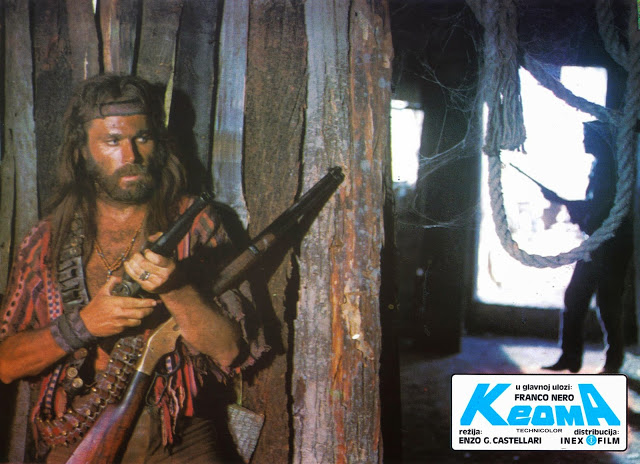 |
| By Generoso Fierro |
By 1976, the mania surrounding the spaghetti western had all but died out. Due to the success of the Godfather films, Italian crime dramas were all the rage and the few westerns that were being produced in Europe fell more into the comedic realm than the dramatic one due to the success of the Terence Hill/Bud Spencer films that became extremely popular in the early part of the decade.
Even veteran directors like Enzo Castellari, who had directed several superb spaghetti westerns, including Johnny Hamlet, had moved on to Italian crime dramas, as did the genre’s biggest star, Franco Nero, of Django fame.
Gone was Nero’s cowboy hat in favor of his Borsalino; that is until Keoma.
There is a real reverence for all westerns in Keoma, which was written and directed by Castellari and released in 1976. I say “all westerns” because the film is packed with many of the standard motifs of fellow Italian western directors, Corbucci and Leone but also Sam Peckinpah and even John Ford.
I guess if this was to be Castellari’s last western, he was going to put all of it out on the table.
Playing Keoma (the word means “far away” in Cherokee) is Franco Nero, and he is again the quiet ex-soldier who comes to a town in trouble and who must now fight valiantly to save everyone. There is a plague in the town that is killing everyone, but evil landlord Caldwell is keeping medicine and supplies away from townspeople and is sending the infected to a camp to die. Keoma is half-Native American and was adopted by William Shannon (William Berger), who already had three sons of his own who are now part of Caldwell’s gang. The brothers were brutal to Keoma when he was a child, detesting that their father would raise a half-breed, which is seen during one of the many flashbacks (another key motif in many spaghetti westerns) in the film.
After Keoma rescues a pregnant woman who is about to be sent to camp, he draws the ire of Caldwell’s men, setting up the conflict of the film. The dour and almost hopeless tone of these scenes rival Sergio Corbucci’s, The Great Silence, the 1968 film that set the standard for surrealistically depressing westerns for years to come.
 |
| Keoma lobby card |
Many of the gunfights that ensue are those of the Peckinpah variety, with long slow motion shots of diving shooters and the over pronounced sounds of ricochets, but as so many spaghetti westerns have taken their cues from Peckinpah, this is not a surprise.
What is a surprise influence in the film is Ingmar Bergman, whose inspiration takes form in a witch (Gabriella Giacobbe) who speaks to our ex-solider Keoma in the same way about the purpose of it all as the Grim Reaper would speak with Antonious in The Seventh Seal. Our witch is asking Keoma why he would put the effort in to save a town that is beyond saving; however, Keoma is there to not only to save the people of his town but to correct the wrongs that had been done to him as a boy.
Nero is great in the titular role, as is the cast, which was comprised of many spaghetti western regulars doing some of their finest work.
What sadly hurts Keoma, though not fatally, is the ear-piercing folksy soundtrack. It has been written that during filming, Castellari had been enamored of the music that Leonard Cohen had done for Altman’s McCabe and Mrs. Miller and wanted something that worked in the same way to propel the narrative.
Unfortunately, the virtually shrieking vocals from the soundtrack composed by the De Angelis brothers and sung by Sybill and Guy bombard many scenes in the film and do not give the same kind of earthy goodness that Cohen’s tracks give Altman’s revisionist masterpiece.
The soundtrack is an otherwise small mistake in a film that provides a somber yet triumphant elegy to the spaghetti western. Like previous films in the spaghetti western genre, Keona uses every cliché available to tell it’s grim story, but this isn’t a cheaply made lark thrown together to try and cash in on a trend.
No, it is an elegantly composed farewell by Castellari and Nero to a kind of film that clearly meant so very much to them and all of those who still loved the raw storytelling of the spaghetti western.








































































































